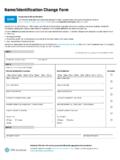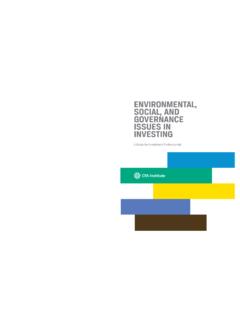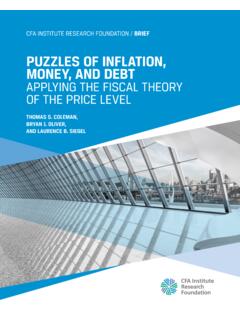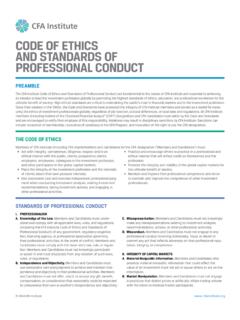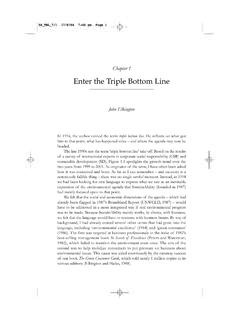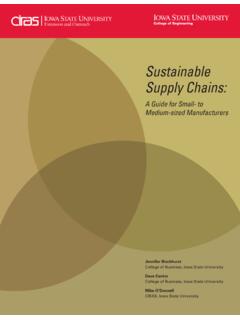Transcription of CERTIFICATE IN ESG INVESTING V.3 TESTED FROM 1 …
1 ViiiCFA INSTITUTECERTIFICATE IN ESG INVESTING TESTED FROM 1 OCTOBER 2021 UNIT AIMS By the end of this unit, learners should be able to demonstrate: An understanding of the context for different approaches to responsible investment and specifically, consideration of environmental, social and governance (ESG) factors. An understanding of the underlying issues that constitute factors within each of the environmental, social and governance areas. An understanding of the broader sustainability context and global initiatives. An understanding of the ESG market: relevance, size, scope, key drivers and challenges, and risks and opportunities. An understanding of environmental factors, systemic relationships, material impacts, megatrends and approaches to environmental analysis at country, sector and company levels.
2 An understanding of social factors, systemic relationships, material impacts and approaches to social analysis at country, sector and company levels. An understanding of governance factors, key characteristics, main models and material impacts. An understanding of engagement and stewardship. An understanding of ESG analysis, valuation and integration. An ability to analyse how ESG factors may affect industry and company performance, and security valuation across a range of asset classes. An understanding of ESG integrated portfolio construction and management. An ability to apply a range of approaches to ESG analysis and integration across a range of asset classes. An understanding of investment mandates, portfolio analytics and client ALLOCATION:Question allocation across the syllabus is balanced on the guidance of psychometric and industry specialists.
3 The following question allocation for Version 3 of the CERTIFICATE in ESG INVESTING is provided as a broad indication of the relative weighting of different parts of the syllabus in examinations from 1 October nameQuestion allocation1 Introduction to ESG4 82 The ESG market4 83 Environmental factors6 124 Social factors6 125 Governance factors6 126 Engagement and stewardship6 107 ESG analysis, valuation and integration20 328 ESG integrated portfolio construction and management8 149 Investment mandates, portfolio analytics and client reporting4 8 OTHER INFORMATION REGARDING THIS UNIT:Exam format: Time allowed for exam: Grades: Study materials: Recommendedstudy hours:Availability of exam appointments: l100 ine testing using standard multiple choice and item set hours and 20 minutesl Pass or Official Training Manual Edition 3 will be available on the CFA Institute Mock exam on CFA Institute Every working day through Prometric testing centres and every day via ProProctor remote-proctored 1 INTRODUCTION TO ESGBy the end of this topic, learners should have: An understanding of the context for different approaches to responsible investment and specifically, consideration of environmental, social and governance (ESG) factors.
4 An understanding of the underlying issues that constitute factors within each of the environmental, social and governance areas. An understanding of the broader sustainability context and global INTRODUCTION TO Define Define the following sustainability -based concepts in terms of their strengths and limitations: Corporate social responsibility. triple bottom line (TBL) Define different approaches to ESG INVESTING , their characteristics and the role that ESG plays in each of them. Responsible investment. Socially responsible investment (SRI). Sustainable investment. Best-in-class investment. Ethical/values-driven investment. Thematic investment. Impact investment. Green investment. Social investment. Shareholder Describe the benefits to organisations of adhering to good practice in ESG, and the linkages between these practices and financial system stability: reduce costs and increase efficiency; reduce risk of fines; avoid costs from repercussions of investee s externalities; and improve ability to benefit from sustainability megatrends.
5 Describe the challenges to organisations of adhering to good practice in ESG including: Investment mandate interpretation and screening application. Isolating the impact of ESG. Strategy definition: risk management versus value creation/materiality. Portfolio construction and management tools. Disclosure of internal standards and practices. Data quality, variability and interpretation. Identifying material ESG factors. Explain the materiality of ESG issues in terms of their key characteristics, risks and impact that they can Explain different ESG megatrends, their systemic nature and potential impact on companies and company practices. Explain how ESG INVESTING is a strategy and a practice, and the three ways in which investors typically reflect ESG Explain the aims, elements and progress achieved by key supranational ESG initiatives and organisations: United Nations initiatives.
6 Reporting initiatives. Other 2 THE ESG MARKETBy the end of this topic, learners should have: An understanding of the ESG market: relevance, size, scope, key drivers and challenges, and risks and THE ESG Explain the history of ESG INVESTING in brief, including its roots and modern responsible Explain the size and scope of ESG INVESTING in relation to: Geography. Strategy. Investor type. Asset Explain key market drivers in favour of ESG integration: investor demand/intergenerational wealth transfer; regulation and soft law ; public awareness; data sourcing and processing Explain the key drivers and challenges for ESG integration among stakeholders within the investment industry: Asset owners. Asset managers. Fund promoters. Financial services.
7 Policy makers and regulators. Investees. Government, civil society and academia. Explain how ESG issues are related to sustainability trends and themes within the investment industry, including: the longer-term nature of ESG INVESTING ; ESG-driven market, organisational and cultural 3 ENVIRONMENTAL FACTORSBy the end of this topic, learners should have: An understanding of environmental factors, systemic relationships, material impacts, megatrends and approaches to environmental analysis at country, sector and company ENVIRONMENTAL Explain key concepts relating to climate change from an evidence-based perspective, including: Climate change. Climate change mitigation. Climate change adaptation and resilience measures. Explain key concepts relating to other environmental issues from an evidence-based perspective, including: Pressures on natural resources, including depletion of natural resources, water, biodiversity loss, land use and marine resources.
8 Pollution, waste and a circular Explain the systemic relationships between business activities and environmental issues, including: Systemic impact of climate risks on the financial system: climate-related physical and transition risks. The relationship between natural resources and business. Supply, operational and resource management issues. Supply chain transparency and Assess key megatrends influencing environmental change in terms of potential impact on companies and their environmental practices: Growth of environmental and climate policies. International climate and environmental agreements and conventions. International, regional and country-level policy and initiatives. Carbon Assess material impacts of environmental issues on potential investment opportunities, including the dangers of overlooking them: Corporate and project finance.
9 Public Finance initiatives. Asset Identify approaches to environmental analysis in both developed and emerging countries, including: Company, project, sector, country and market level analysis. Environmental risks including carbon footprinting and other carbon metrics, natural capital approach and climate scenario Apply material environmental factors to financial modelling, ratio analysis and risk Explain how companies and the investment industry can benefit from opportunities relating to climate change and environmental issues: Circular economy. Clean and technological innovation. Green and ESG-related products. Blue 4 SOCIAL FACTORSBy the end of this topic, learners should have: An understanding of social factors, systemic relationships, material impacts and approaches to social analysis at country, sector and company SOCIAL Explain the systemic relationships and activities between business activities and social issues, including: Globalisation.
10 Automation and artificial intelligence (AI). Inequality and wealth creation. Digital disruption, social media and access to electronic devices. Changes to work, leisure time and education. Changes to individual rights and responsibilities, and family structures. Changing demographics, including health and longevity. Urbanisation. Assess key megatrends influencing social change in terms of potential impact on companies and their social practices: Climate change. Transition risk. Water scarcity. Pollution. Mass migration. Loss and/or degradation of natural resources and ecosystem Explain key social concepts from an evidence-based perspective: Human capital: -development;- employment standards; and - health and safety. Product liability/consumer protection: -safety;-quality;- health and demographic risks; and - data privacy and security.

